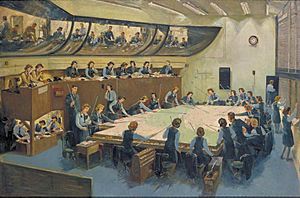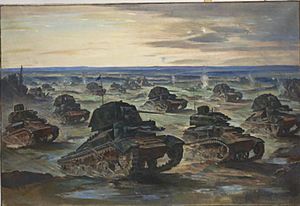Charles Cundall facts for kids
Charles Ernest Cundall (born September 6, 1890 – died November 4, 1971) was an English painter. He was known for his paintings of places, cities, and landscapes. He was especially famous for his large, wide paintings that showed a lot of detail.
Becoming an Artist
Charles Cundall was born in Stretford, Lancashire, England. Before becoming a painter, he worked as a designer. He created patterns for pottery and stained glass windows.
He studied art at the Manchester School of Art. In 1912, he won a special scholarship to attend the Royal College of Art.
During World War I, Charles served in the Royal Fusiliers. He was hurt in his right arm during the war. This meant he had to learn to paint using his left arm instead! After recovering, he went back to the Royal College of Art in 1918. He also studied at the Slade School of Art and in Paris.
Charles loved to travel. In the 1920s, he visited many countries. He explored Italy, Sweden, Russia, and Spain. His travels inspired many of his paintings.
In 1927, he had his first art show. He became well-known for his big, wide paintings. One famous painting is Bank Holiday, Brighton from 1933. This painting is now kept in the Tate art museum. Charles also took part in art competitions at the Olympic Games in 1928, 1932, and 1948.
Painting During World War II
When World War II began, Charles Cundall was hired by the War Artists' Advisory Committee. This group asked artists to create paintings about the war. Charles first worked as an artist for the Merchant Navy. He painted scenes of ships and sea activities. He spent time painting along the River Thames and in the West Country of England.
In 1941, he started painting for the Air Ministry. This meant he painted subjects related to the Royal Air Force and Coastal Command. In 1942, he painted American troops arriving in Northern Ireland. He also worked in Scotland that year.
One of his most famous paintings from the war is The Withdrawal from Dunkirk, June 1940. This painting shows the famous evacuation of soldiers from Dunkirk. Charles did not see the event himself. He used stories, photos, and reports to create his large painting. Another artist, Richard Eurich, also painted the Dunkirk evacuation. Both paintings were shown together in London. People had different opinions about which painting was better. Many felt that Charles's painting, with all its details, felt very real to those who had been there.
Towards the end of the war, King George VI bought two of Charles's paintings. These paintings showed wartime activities in Windsor Great Park.
His Legacy
Charles Cundall was a member of several important art groups. These included the Royal Watercolour Society and the Royal Society of Portrait Painters. He regularly showed his art at the Royal Academy. He became a full member of the Royal Academy in 1944.
Charles was married to another artist named Jacqueline Pietersen.
Today, you can see Charles Cundall's artwork in many places. His paintings are in the Tate museum, the Imperial War Museum, and the RAF Museum. You can also find his art in galleries in Liverpool, Manchester, and Bristol.





